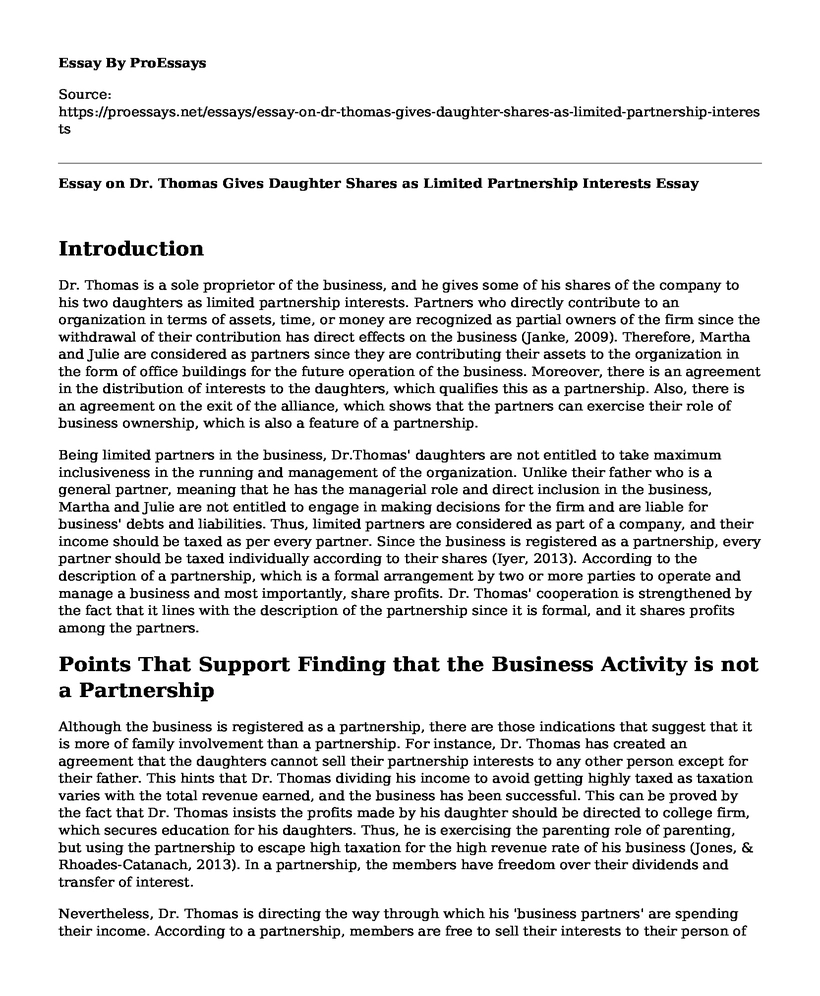Introduction
Dr. Thomas is a sole proprietor of the business, and he gives some of his shares of the company to his two daughters as limited partnership interests. Partners who directly contribute to an organization in terms of assets, time, or money are recognized as partial owners of the firm since the withdrawal of their contribution has direct effects on the business (Janke, 2009). Therefore, Martha and Julie are considered as partners since they are contributing their assets to the organization in the form of office buildings for the future operation of the business. Moreover, there is an agreement in the distribution of interests to the daughters, which qualifies this as a partnership. Also, there is an agreement on the exit of the alliance, which shows that the partners can exercise their role of business ownership, which is also a feature of a partnership.
Being limited partners in the business, Dr.Thomas' daughters are not entitled to take maximum inclusiveness in the running and management of the organization. Unlike their father who is a general partner, meaning that he has the managerial role and direct inclusion in the business, Martha and Julie are not entitled to engage in making decisions for the firm and are liable for business' debts and liabilities. Thus, limited partners are considered as part of a company, and their income should be taxed as per every partner. Since the business is registered as a partnership, every partner should be taxed individually according to their shares (Iyer, 2013). According to the description of a partnership, which is a formal arrangement by two or more parties to operate and manage a business and most importantly, share profits. Dr. Thomas' cooperation is strengthened by the fact that it lines with the description of the partnership since it is formal, and it shares profits among the partners.
Points That Support Finding that the Business Activity is not a Partnership
Although the business is registered as a partnership, there are those indications that suggest that it is more of family involvement than a partnership. For instance, Dr. Thomas has created an agreement that the daughters cannot sell their partnership interests to any other person except for their father. This hints that Dr. Thomas dividing his income to avoid getting highly taxed as taxation varies with the total revenue earned, and the business has been successful. This can be proved by the fact that Dr. Thomas insists the profits made by his daughter should be directed to college firm, which secures education for his daughters. Thus, he is exercising the parenting role of parenting, but using the partnership to escape high taxation for the high revenue rate of his business (Jones, & Rhoades-Catanach, 2013). In a partnership, the members have freedom over their dividends and transfer of interest.
Nevertheless, Dr. Thomas is directing the way through which his 'business partners' are spending their income. According to a partnership, members are free to sell their interests to their person of choice, and to those they are comfortable to sell to. However, Dr. Thomas has denied his daughter's sovereignty over their interests as he has developed an agreement that he is the only one who can buy the investments. By doing this, he ensures that the company is still under his rule, and the partnership is only helpful in escaping heavy taxation (Monroe, 2012). William is correct that the business does not seem to be a partnership since Martha and Julie are not in any way involved in business activities, and the father literary owns the business and uses the daughters as a way out of paying full taxes.
References
Iyer, E. (2013). Theory of alliances: partnership and partner characteristics. In Nonprofit and Business Sector Collaboration (pp. 48-64). Abingdon, UK: Routledge.Available at: https://www.taylorfrancis.com/books/e/9780203049587/chapters/10.4324/9780203049587-7
Janke, E. M. (2009). Defining characteristics of partnership identity in faculty-community partnerships. Creating our identities in service-learning and community engagement. Advances in service-learning research, 75-102. Retrieved from: https://www.infoagepub.com/products/Creating-Our-Identities-in-Service-Learning-and-Community-Engagement
Jones, S., & Rhoades-Catanach, S. (2013). Principles of Taxation for Business and Investment Planning, 2014 edition. McGraw-Hill Higher Education. Retrieved from: https://www.slideshare.net/madeehaoconnorly/pdf-download-principles-of-taxation-for-business-and-investment-planning-2014-ebook-pdf
Monroe, A. (2012). Integrity in taxation: Rethinking partnership tax. Alabama. Law. Review., 64(2), 280- 289. Retrieved at: https://www.law.ua.edu/pubs/lrarticles/Volume%2064/Issue%202/3%20Monroe%20289%20-%20334%20Final%20CROPPED.pdf
Cite this page
Essay on Dr. Thomas Gives Daughter Shares as Limited Partnership Interests. (2023, Jan 26). Retrieved from https://proessays.net/essays/essay-on-dr-thomas-gives-daughter-shares-as-limited-partnership-interests
If you are the original author of this essay and no longer wish to have it published on the ProEssays website, please click below to request its removal:
- Local and Global Business Opportunities for Countries Paper Example
- TechStars Startup Weekend: Innovation and Entrepreneurship Paper Example
- Leadership Through Innovation Paper Example
- Constitutional Law and Business Regulation Essay Exaample
- Essay Sample on Hospitality Industry Transforms to Meet Digital Age
- International Expansion: Navigating the Competitive Global Marketplace - Research Paper
- Essay Example on Unlock Your Potential: How Governments Encourage Entrepreneurship







